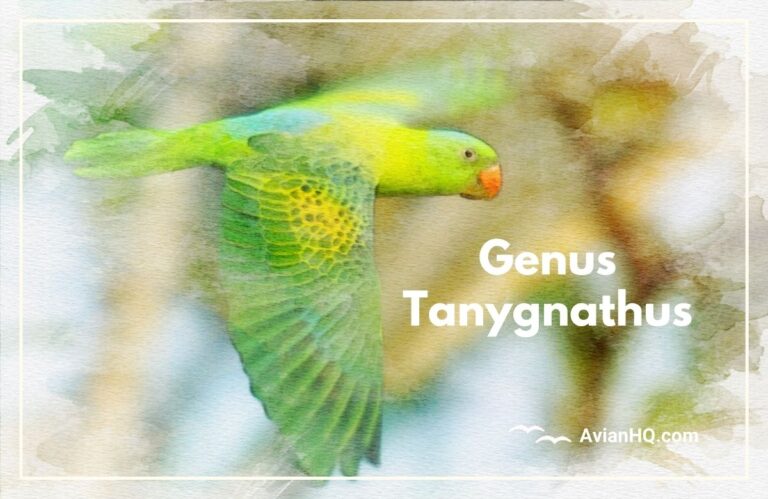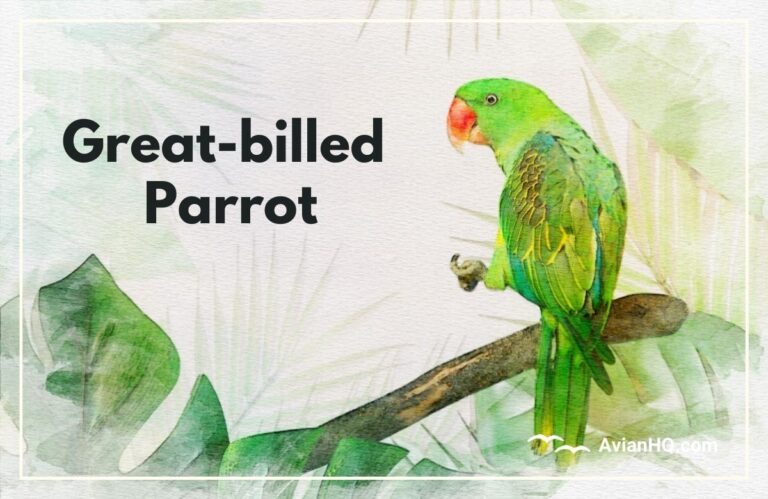Black-lored Parrot (Tanygnathus gramineus)
The Black-lored Parrot (Tanygnathus gramineus), also known as the Buru Green Parrot, is a beautiful green parrot endemic to the remote Indonesian island of Buru. With it’s dazzling blue crown and distinctive black face markings, this rare tropical parrot has captivated ornithologists and bird enthusiasts alike ever since it’s discovery over 200 years ago.
Yet despite it’s vibrant colors, the Black-lored Parrot remains one of the least understood parrots in the world. Largely nocturnal and inhabiting dense mountain forests, this elusive species has rarely been observed in the wild. It’s secluded lifestyle high in the lush Buru rainforests has prevented extensive scientific study, leaving much of it’s behavior, ecology and conservation status shrouded in mystery.
In this article, we will explore everything known about this remarkable and little-known parrot. We will cover it’s identification, distribution, diet, breeding habits, relationships with local islanders, and the threats it currently faces in the wild. Along the way, you will have the chance to admire the Black-lored Parrot’s gorgeous plumage and endearing personality while learning how scientists are racing to unravel the secrets of this endangered bird’s secluded realm high in the ancient Buru woodlands.
History and Taxonomy
The Black-lored Parrot was first described scientifically in 1779 by the French naturalist Georges-Louis Leclerc, Comte de Buffon, based on a specimen from the island of Buru. Buffon gave it the name Psittacus gramineus in his monumental natural history compendium Histoire Naturelle des Oiseaux. He also published a remarkable hand-colored illustration of the species that captured it’s graceful form and vibrant green plumage [4].
In 1788, the German biologist Johann Friedrich Gmelin consolidated the taxonomy and nomenclature of all known species in his revised version of Carl Linnaeus’s Systema Naturae. He retained Buffon’s scientific name of Psittacus gramineus for the Black-lored Parrot and cited Buffon’s description and illustration [5].
It was not until 1832 that the German ornithologist Johann Georg Wagler assigned the Black-lored Parrot to it’s current genus Tanygnathus. The name Tanygnathus derives from the Greek words tanyo meaning “to stretch out” and gnathos meaning “jaw”, referring to the characteristic elongated shape of parrots’ beaks.
The specific epithet gramineus given originally by Buffon is Latin for “grass-colored” or “green”, an apt description of the parrot’s predominant green plumage.
Today the Black-lored Parrot remains the only recognized species in the genus Tanygnathus, although some authorities consider it closely related to the Great-billed Parrot (Tanygnathus megalorynchos) and Blue-backed Parrot (Tanygnathus sumatranus) of Indonesia and the Moluccas.
Physical Appearance
The Black-lored Parrot is a moderately sized, slender green parrot measuring about 15.75 inches or 40 centimeters in total length including it’s long graduated tail.
It weighs approximately 8 to 11 ounces or 250 grams on average, similar to related parrots like the Great-billed Parrot.
The adult plumage is predominantly bright green. The crown and forehead feathers are a striking turquoise or blue-gray. A distinctive black band extends from the black lores (featherless areas) below the eyes and around the curved beak, giving rise to the common name Black-lored Parrot.
The lower belly and vent area are more yellow-green compared to the pure green upper breast and back. The lesser wing coverts are also yellow-green edged, contrasting with the deep blue flight feathers (primaries) and green secondaries. The uppertail is green with yellowish tipping, while the undertail is dusky yellow.
The eyes are brownish-yellow with narrow gray periopthalmic rings. The long curved bill is a bright orange-red in adult males, while females have more grayish-brown bills. The feet are grayish.
Juveniles are undescribed but likely resemble adult females until acquiring the full adult male plumage at around 6 months old.
Distribution and Habitat
The Black-lored Parrot is endemic to the island of Buru in the Maluku archipelago of Indonesia. Buru lies between the islands of Seram to the west and Ambon to the southeast.
The parrot is found predominantly in the mountainous forests in central Buru between approximately 2,000 and 5,500 feet (600 to 1,700 meters) elevation. It’s stronghold is the hilly northwest region including areas like Gunung Tagalago.
It also occurs locally in lowland and hill forests near the southern and northeastern coasts at elevations down to sea level.
The total area of suitable montane forest habitat on Buru is estimated at 1,789 square kilometers (691 square miles) above 2,950 feet (900 meters) and 872 square kilometers (337 square miles) above 3,900 feet (1,200 meters).
Population densities observed in the wild range from 1.3 to 19 individual birds per square kilometer (0.5 to 7 birds per square mile) of suitable habitat. The total wild population is very roughly estimated at between 3,500 and 15,000 mature individuals.
Diet and Feeding
Although direct observations of foraging are limited, the diet of the Black-lored Parrot is presumed to consist primarily of various fruits, berries, seeds and nuts, as in related parrot species.
In the wild, they likely forage for seasonal fruits and berries from trees such as figs, palms, and moluccan almonds in the rainforest canopy. Smaller nuts and seeds are also readily consumed.
Their powerful curved beaks and specialized tongues help them access and open hard nuts and seeds. Zoo specimens have been reported to have a varied diet including seeds, nuts, fruits, vegetables, and some manufactured pellets to provide balanced nutrition.
Further study of wild feeding ecology and diet is needed to better understand the relationships between Black-lored Parrots and the particular native flora of Buru upon which they depend. Protecting areas of intact native forest that supply their preferred natural food sources is crucial for conservation.
Breeding and Reproduction
Very little is known about the breeding habits of the Black-lored Parrot in the wild. Like many parrots it is believed to nest in tree cavities, but no nests have been documented.
Based on limited observations and testimony from local Buru residents, the clutch size is presumed to be 2-3 eggs. The eggs are likely incubated for 22-24 days as in related species.
The chicks probably fledge at 8-10 weeks, and juvenile birds may take up to 6 months to acquire full adult plumage based on the maturation period for adult male coloration. However the breeding season, incubation duties, and developmental milestones remain unconfirmed and in need of further field study.
In captivity, Black-lored Parrots have been reported to breed successfully when provided an adequate nest box approximately 12 x 8 x 24 inches (30 x 20 x 60 cm) lined with wood chips or shavings. However captive breeding remains extremely limited due to the rarity of this species in aviculture.
Overall, very little is known about the reproductive behavior of this shy and elusive species in the dense mountain forests of Buru. More observations of wild pairs and nests are critically needed to support conservation.
Behavior and Ecology
The behavior and ecology of the Black-lored Parrot are poorly understood as this species is difficult to observe in the wild. They are described as quiet and shy birds that are active both during the day and at night.
Black-lored Parrots roost in the forest canopy, often becoming active shortly after sunset. Their unique vocals are described as more shrill, drawn-out, and high-pitched compared to related parrots. Pairs or groups call to each other through the night, which helps locate and study them.
During daylight hours they forage quietly for fruits, nuts and seeds. They may migrate locally between coastal lowlands and mountain forests depending on food availability.
Black-lored Parrots are typically observed alone, in pairs, or in small groups of up to 12 birds. Larger aggregations may form briefly at abundant food sources. They fly with rapid, direct wingbeats characteristic of parrots.
Beyond such fragmentary glimpses, very little is known about their mating systems, territoriality, chick-rearing behaviors, population densities, lifespan, predators, diseases, and other aspects of their life history and ecology. Much more extensive fieldwork is urgently needed.
Conservation Status
Due to it’s small, declining population and habitat loss, the Black-lored Parrot is classified as Vulnerable on the IUCN Red List of Threatened Species.
It’s limited range and specialized habitat make it vulnerable to extinction. The main threat is ongoing deforestation, especially at lower elevations.
Much of Buru’s original lowland forest has already been logged or degraded. However, the mountain forests above approximately 3,000 feet (900 meters) remain relatively intact. Protecting sufficient areas of montane habitat is crucial for the parrot’s survival.
In recent decades, two reserves have been established on Buru that protect portions of the Black-lored Parrot’s range: Gunung Kapalat Mada Reserve (1,380 square km) and Waeapo Reserve (50 square km).
While nest poaching and trade have not been problems thus far, any illegal capture for the pet trade could quickly decimate this species’ tiny population. Strengthened legal protections, anti-poaching measures, and expanded reserves are all vital conservation needs.
Increased ecological study, surveys, monitoring, and community-based conservation initiatives can help secure the future of this mysterious and vulnerable island endemic.
In Captivity
The Black-lored Parrot has been maintained sporadically in captivity by local aviculturists on Buru, but remains virtually unknown in aviculture elsewhere.
Very few examples have been exported from Indonesia due to tight trade restrictions under CITES Appendix II. More study of their behavior and needs in captivity is required to establish best practices for husbandry.
If offered for sale, Black-lored Parrots should be housed in large planted aviaries providing ample opportunity for flight, climbing and enrichment. A varied diet including seeds, nuts, fruits, vegetables and pellets is recommended. Further research is needed on ideal temperature ranges, perching, potential health issues, and other aspects of captive care.
Conclusions
In summary, the beautiful Black-lored Parrot remains one of the most mysterious and little-known members of it’s kind on Earth. As intensified logging continues to eliminate it’s specialized highland rainforest home on Buru, time is running short to unravel the secrets of this shy and vulnerable species.
Expanding protected habitat, field studies, community-based conservation, and international support for the Black-lored Parrot can help secure it’s future while bringing fascinating new insights into Indonesia’s remarkable island biodiversity.





